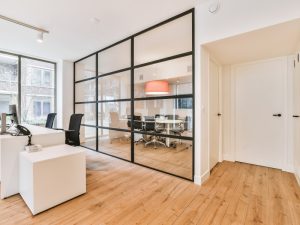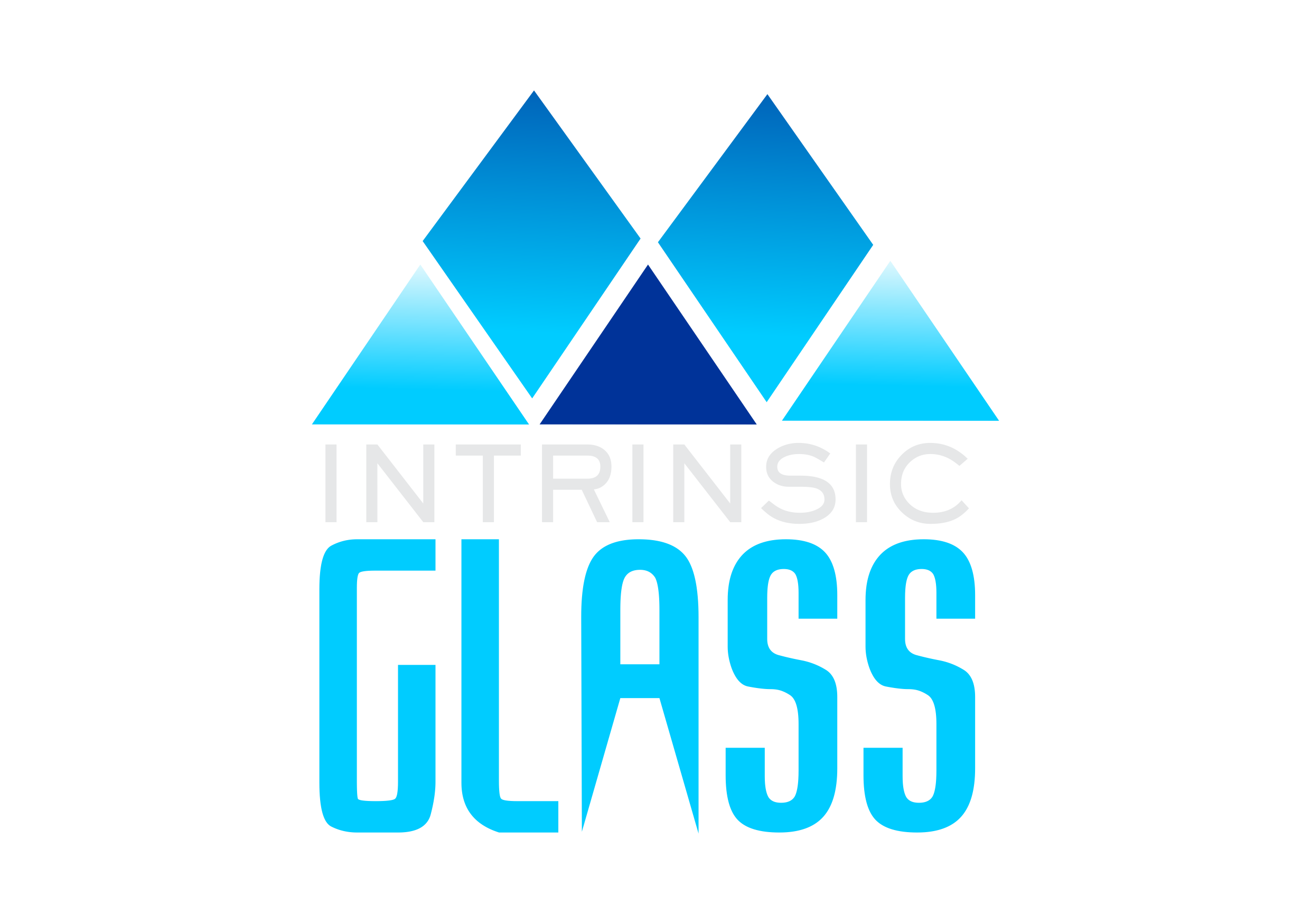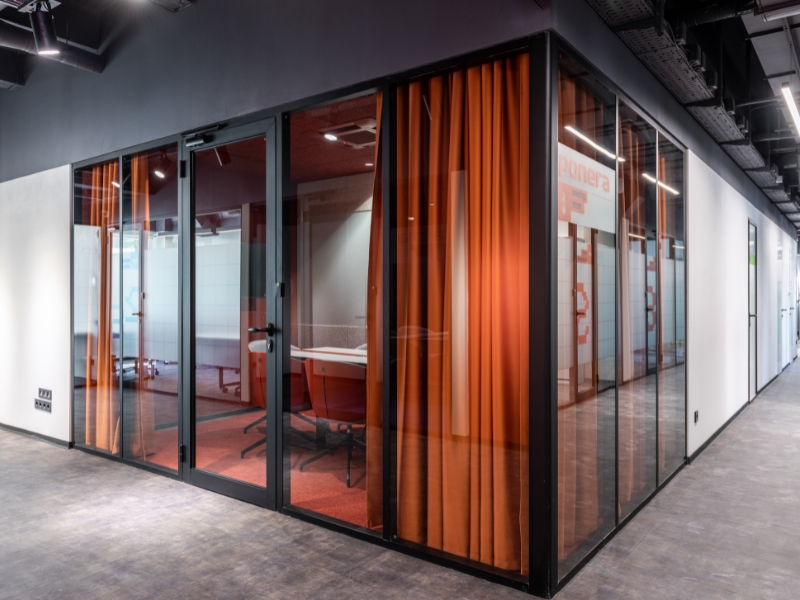Modern workplaces demand more than just visual appeal—they require intelligent layouts that balance openness with privacy. A half-glass partition offers a thoughtful middle ground, allowing natural light to flow while maintaining defined work zones. Unlike full-height walls or fully transparent dividers, this option adapts to evolving office needs without overwhelming the space.
This article explores the practical challenges of traditional and full-glass setups and highlights the design flexibility, materials, and layout benefits that come with choosing a half-glass partition.
Why Are Traditional Partitions Limiting in Modern Offices?
Full-height solid walls were once the go-to for dividing office space, but they come with noticeable disadvantages in modern workplaces. Here are the key limitations of traditional partitions that hold offices back:
- Lack of Light Flow: Closed-off walls block natural light, making the workspace feel dim and enclosed. Poor lighting affects productivity and mood, particularly in central or windowless areas.
- Visual Disconnection: When team members are visually cut off, collaboration drops. It becomes harder to gauge activity in different departments, creating silos in communication.
- Wasted Vertical Space: Solid partitions often waste upper wall space, especially in areas where full-height privacy isn’t necessary. This makes the room feel tighter and reduces opportunities for ventilation and visibility.
- Accessibility & Ergonomic Constraints: These outdated layouts can also make it harder to accommodate mobility aids, visual access needs, and ergonomic flexibility, key considerations in creating an accessible and inclusive workplace.
Replacing these bulky partitions with partial glass dividers reopens the environment without compromising privacy where it’s needed.
How Does a Half-Glass Partition Address Visibility and Privacy?
A half-glass partition blends clear or frosted glass at the top with a solid base, striking a balance between connection and separation. Here are the visibility and privacy advantages of this design:
- Open Upper Views for Natural Light: The glass portion allows light to pass through, keeping work zones bright and reducing reliance on artificial lighting. This is especially valuable in areas without windows.
- Lower Panels for Discretion: The solid lower section serves as a privacy barrier, blocking screen visibility, accidental glances, and exposure to confidential workspaces.
- Balanced Collaboration: Employees can still feel part of the larger environment without being completely exposed. It keeps the open-plan feel while clearly defining each workspace.
The result is a more functional and employee-friendly environment—one that supports communication, enhances comfort and respects individual privacy. You can also explore complete office layout solutions with a half-glass partition to see how this approach aligns with the evolving needs of modern workplaces.
Can a Half-Glass Partition Make Small Offices More Functional?
Small workspaces benefit greatly from efficient partitioning, but the wrong choices can make them feel cramped. Here are the ways half-glass partitions improve compact office layouts:
- Spatial Illusion: Clear upper panels create the illusion of space, making rooms feel larger without needing additional square footage. This effect is amplified when aligned with natural light sources.
- Light Penetration in Tight Corners: Unlike full partitions, half-glass allows light to travel deeper, which is crucial for areas with limited windows or shared lighting.
- Defined yet Open Areas: They provide zoning without claustrophobia. You can create mini meeting areas, hot desks, or quiet zones while maintaining visual openness.

For even more creative planning ideas, discover the space-saving benefits of partial glass walls.
What Materials Work Best in Half-Glass Partition Designs?
Material selection directly affects the performance and appearance of your partition system. From aesthetics to acoustics, your choice matters. Here are the most effective materials to use in half-glass partition installations:
- Glass Types: Clear vs Frosted: Clear tempered glass maximises visibility and is ideal for collaborative spaces. Frosted or tinted glass adds privacy, making it perfect for private offices or areas where discretion is crucial.
- Lower Panel Options: Solid materials like laminated MDF, acoustic panels, or even fabric-covered boards help block noise and hide under-desk clutter. These can also be customised with corporate colours or branding.
- Structural Frames: Aluminium or powder-coated steel frames provide durability and support. Choose sleek metallic finishes for modern offices or matte tones for minimalism.
- Finishing Touches: Optional accents like timber trims or perforated metal panels can enhance the design further while reflecting your brand’s personality.
Understanding these material options allows businesses to make informed design decisions that reflect their space usage, acoustic needs, and visual identity without compromising functionality or style.
Are Half-Glass Partitions Adaptable to Different Office Styles?
Yes—this flexibility is one of the top reasons businesses choose them. Here are the office design styles where half-glass partitions thrive:
- Modern Minimalism: Think clean lines, neutral colours, and plenty of light. Clear glass with slim aluminium frames fits seamlessly into this look.
- Industrial Workspaces: Matte black or steel frames paired with frosted glass echo the rugged, exposed materials often found in converted warehouse offices.
- Scandinavian-Inspired: Light timber frames with white panels and semi-transparent glass reflect the Nordic emphasis on warmth and simplicity.
- Traditional or Corporate: Frosted glass and solid wood lower panels lend a classic feel, suitable for legal or finance firms, while still modernising the space.

Another bonus? These partitions promote airflow. See how glass elements affect air circulation in open-plan offices for better indoor comfort.
Choosing the Right Half-Glass Partition for Your Workspace
Understanding the role of half-glass partitions in office design goes beyond just aesthetics. Their value lies in providing a strategic balance, encouraging natural light while protecting personal space, and promoting openness without losing order. As explored, these partitions adapt across different industries, team sizes, and layout demands, with a variety of materials and finishes to support unique working environments.
By carefully considering how your team uses space, what level of privacy is necessary, and how design influences mood and productivity, businesses can identify the most effective configuration. Whether incorporated into traditional offices or more creative settings, they remain a timeless and practical addition. For tailored ideas, industry examples, and technical perspectives, you can explore custom partition solutions with Intrinsic Glass to see how different combinations of materials and layouts come together in real-world applications.

